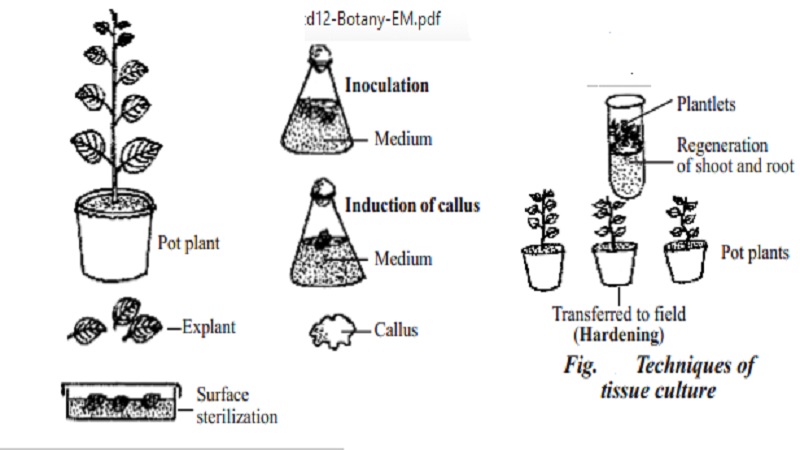Chapter: 11 th 12th std standard Bio Botany plant tree Biology Higher secondary school College Notes
Basic techniques of plant tissue culture

Basic techniques of plant tissue culture
1. Culture vessels
The culture vessels used for plant tissue studies includes Erylenmayer flask (conical flask), petri plates and culture tubes (25 x 150mm).
2. Culture medium
The important media used for all purpose experiment are Murashige and Skoog medium (MS medium), Gamborg medium (B5 medium), White medium (W medium) and Nitsch medium. The culture medium is closed with cotton plug/ or aluminium foil sheet. The pH of the medium is adjusted to 5.8 (acidic range).
3. Sterilization
Sterilization is the technique employed to get rid of the microbes such as bacteria and fungi in the culture medium and plant tissues. So, it is important to sterilize the culture medium and plant tissue. The culture medium can be sterilised by keeping it in an autoclave and maintaining the temperature of 121-C for 15 minutes. The plant tissue (inoculum) is to be surface sterilised.
Chemical sterilization
By treating the inoculum in any one of the chemical sterilizant such as Sodium hypochlorite, Calcium hypochlorite, Mercury chloride for 15 to 20 minutes followed by repeated washing in sterile water upto 3 to 5 times.
4. Inoculation
Transfer of explant (root, stem, leaf, etc.) on to a culture medium is called inoculation. The inoculation is carried out under aseptic condition for which an apparatus called laminar air flow chamber is used. Flamed and cooled forceps are used for transfer of plant materials to different culture media kept in glasswares.
5. Incubation
The culture medium with the inoculum is incubated at 26 - 2oC with the light intensity at 2000 to 4000 lux (unit of intensity of light) and allowing photoperiod of 16 hour of light and 8 hours of darkness.
6. Induction of callus
Due to activity of auxins and cytokinins, the explant is induced to form callus. The callus is an unorganized mass of undifferentiated tissue. The mechanism of callus formation is that auxin induce cell elongation and cytokinin induces cell division as a result of which masses of cells are formed.
7. Morphogenesis
Formation of new organs from the callus under the influence of auxin and cytokinin is called morphogenesis. Roots and shoots are differentiated from the callus. Such embryos are called somatic embryos result in the formation of young plantlet.
There are two types of morphogenesis
a. Organogenesis
Formation of new organs such as shoot and root is known as organogenesis. The development of shoot from the callus is called caulogenesis and formation of root is called rhizogenesis respectively.
b. Embryogenesis
Formation of embryos (ie. bipolar structure having shoot and root) from the callus is called embryogenesis. These embryos arise from somatic callus tissue and are called somatic embryos or embryoids or somaclonal embryos.
8. Hardening
Exposing the plantlets to the natural environment in a stepwise manner is known as hardening. Finally the plantlets are gradually transferred to the soil.
Status of tissue culture technology in India
India is reported to have one of the largest groups of tissue culture scientists in the world. Most of the research is directed towards the development of improved plants for agriculture, horticulture and forestry using tissue culture methods.
The Department of Biotechnology (DBT), Government of India, New Delhi is playing a vital role in promoting research in the area of plant tissue culture. Several laboratories are being supported by providing funds for development of tissue culture technology for the improvement of crop plants.
The important Biotechnology centres are
i. Indian Agricultural Research Institute (IARI), New Delhi.
ii. Bhaba Atomic Research Centre (BARC), Mumbai.
iii. Central Institute of Medicinal and Aromatic plants (CIMAP), Lucknow.
iv. Dr.M.S. Swaminathan Research Institute (MSSRI), Chennai.
Related Topics